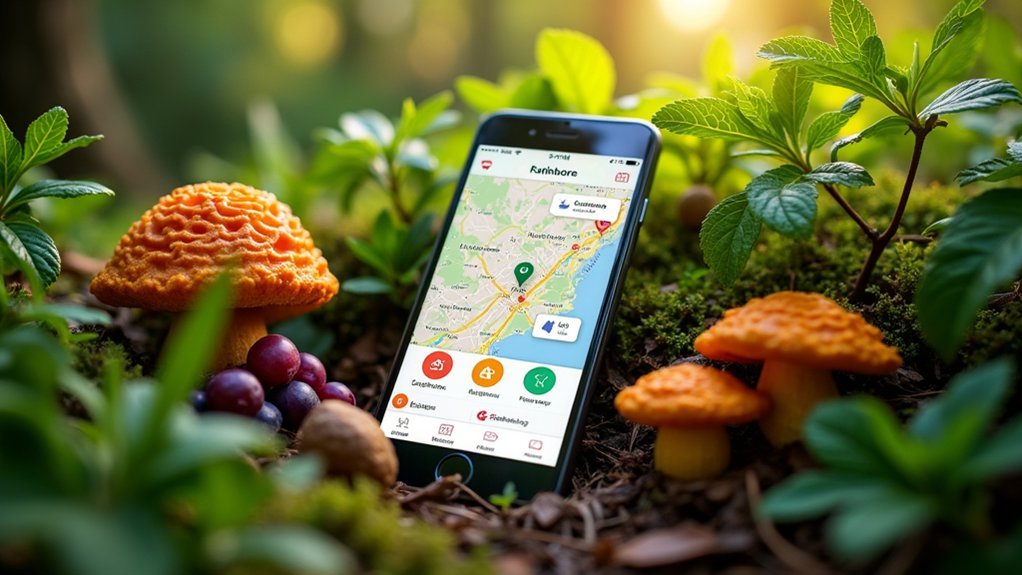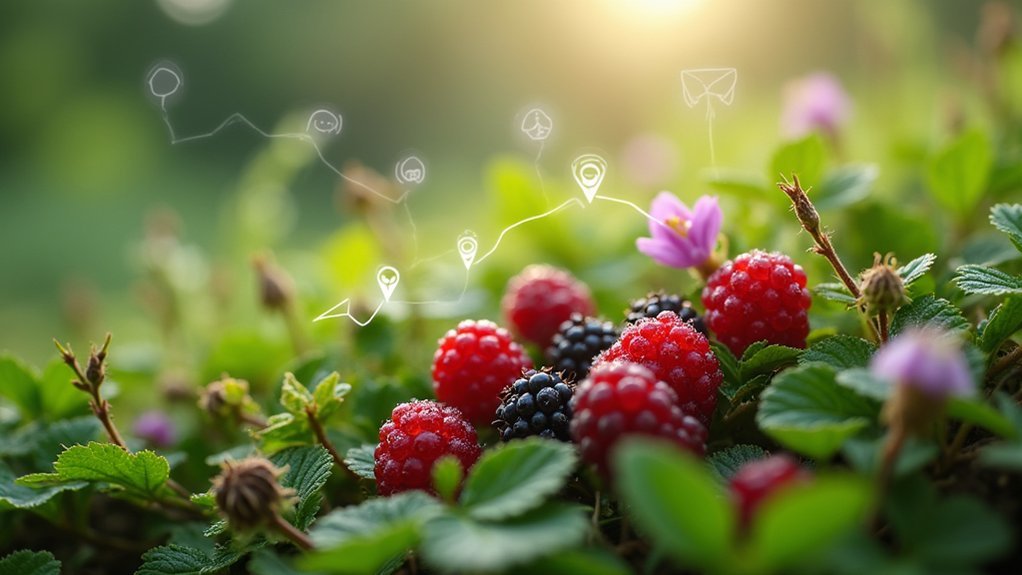The ideal wild food app needs seven essential features: advanced plant identification using machine learning, offline database access for remote areas, thorough safety warnings, seasonal foraging calendars, location-based discovery tools, community engagement options, and recipe integration for your harvested ingredients. You'll benefit from high accuracy identification rates near 97%, downloadable maps for wilderness trips, and toxic look-alike alerts to guarantee safe foraging. These digital tools transform casual plant enthusiasts into confident wild food foragers.
7 Must-Have Features For Wild Food Apps

While foraging for wild foods has been practiced for millennia, modern technology has transformed this ancient skill into an accessible hobby through specialized apps.
These digital tools offer extensive plant identification systems with detailed profiles, seasonal availability tracking, and safety guidelines to guarantee responsible harvesting.
Modern foraging apps provide comprehensive identification, seasonal guidance, and safety protocols ensuring ethical wild food collection.
The best wild food apps leverage location-based recommendations using GPS to suggest nearby foraging spots with maps of plant distribution.
You'll want features that allow offline accessibility for remote areas without reception.
Look for apps with user-generated content capabilities where you can contribute notes, create personalized trails, and interact with other foragers.
Advanced search options should let you filter by plant characteristics, dietary preferences, or specific habitats.
For beginners, integrated guides and organized databases make identification simpler while experienced foragers benefit from collaborative update systems.
A well-designed wild food app should include a recipe database to help users maximize the culinary potential of their foraged finds.
Plant Identification With Machine Learning Technology
Modern foraging apps must employ cutting-edge machine learning technology that can analyze plant features with high accuracy, distinguishing between edible and poisonous lookalikes.
You'll want an app that offers real-time recognition capabilities, allowing you to identify plants instantly while you're in the field without connectivity delays. These advanced systems can categorize over 300,000 plant classes and provide detailed information about each species.
The best apps also include offline identification features, ensuring you can confidently forage even in remote areas without cell service.
Accuracy Through Image Analysis
Machine learning technology revolutionizes wild food identification with unprecedented precision. Deep convolutional neural networks can achieve identification accuracy rates up to 96.98%, making foraging safer and more accessible for you.
Your wild food app needs robust image analysis capabilities that can handle varied lighting conditions and plant angles. Look for apps that utilize data augmentation and transfer learning to guarantee accurate identification across diverse environments. Apps like Forage – Wild Free Food leverage machine learning search to help foragers identify plants through photo submissions.
The best apps combine high-quality plant databases with cross-validation techniques that examine multiple photos of the same plant.
An effective app should allow you to upload several images, provide detailed plant profiles, and offer nutritional information. The system should also incorporate user feedback mechanisms to continuously improve its accuracy and reduce misidentifications of potentially toxic lookalikes.
Real-Time Recognition Capabilities
Real-time recognition capabilities transform the foraging experience by enabling instantaneous plant identification wherever you are.
Advanced machine learning algorithms analyze key plant features through your camera, delivering immediate results without requiring botanical expertise.
- Immediate Feedback: Feel the excitement of identifying unfamiliar plants on the spot, eliminating the uncertainty of traditional foraging.
- Confidence in Safety: Gain peace of mind knowing you can quickly distinguish edible plants from dangerous lookalikes.
- Learning Acceleration: Experience the satisfaction of building knowledge faster as you receive instant confirmations of your identifications.
- Expanded Exploration: Enjoy the freedom to venture further into new environments, knowing identification tools are always at your fingertips.
This technology continually improves through AI learning from user interactions and regular algorithm updates reflecting new botanical discoveries. The addition of recognition features would enhance existing apps like Wild Edibles which already offers comprehensive information on habitat and seasons of plants.
Offline Identification Features
What happens when you're deep in the wilderness with no cell signal? That's when offline identification becomes essential for any worthwhile wild food app.
You'll need technology that doesn't rely on an internet connection to identify potentially edible plants safely and quickly.
The best wild food apps incorporate machine learning technology that works completely offline. These sophisticated systems analyze plant photos you take, instantly comparing them against extensive databases stored on your device. They learn from your interactions, improving accuracy over time even without connectivity. Many serious foragers prefer apps like Wild Edibles Lite which provides multiple pictures per plant to assist with accurate identification.
This offline capability isn't just convenient—it's a safety imperative. When you're hours from civilization and encounter an unfamiliar plant, you can't afford to wait for a signal to determine if it's safe to consume or potentially toxic.
Offline Access to Plant Database and Maps
You'll need reliable offline access to plant databases when foraging in remote areas without cellular coverage.
Download thorough plant information and detailed maps before heading out to guarantee you can identify species and track your location even in signal-free zones.
This critical feature lets you confidently navigate trails, identify edible plants, and avoid dangerous look-alikes without depending on internet connectivity. The best apps provide a downloading process status that shows your progress as information is stored locally on your device.
Essential When Signal-Free
When venturing into remote wilderness areas, reliable offline access to plant databases and maps becomes non-negotiable for any serious forager.
You'll need thorough plant information—including multiple images, detailed descriptions, and look-alike warnings—all available without an internet connection.
- Never risk your safety with partial plant information when identifying potential edibles in signal-dead zones.
- Explore with confidence using offline GPS capabilities and trail maps that guide you to prime foraging locations.
- Return to your discoveries by marking plant locations for future harvests without relying on connectivity.
- Identify accurately through offline machine learning and image recognition that works regardless of your location's cellular coverage.
Download Before Venturing
Before heading into the wilderness, dedicated foragers must download all critical data to guarantee uninterrupted access to plant information regardless of connectivity.
An extensive offline plant database provides detailed descriptions, high-quality images, and information about common species and their potentially dangerous look-alikes.
You'll also need downloadable maps that work without signal. These allow you to mark and save specific foraging locations, track your route through unfamiliar terrain, and record notes about individual plant discoveries.
The best apps offer nutritional information and preparation methods for your finds, all accessible when you're deep in remote areas.
This pre-downloaded content guarantees you'll have expert guidance at your fingertips even when cell service disappears, making your foraging expedition both safer and more productive.
Safety Warnings and Toxic Look-alike Alerts

The difference between a delicious meal and a trip to the hospital often hinges on accurate plant identification. Your foraging app should feature extensive toxic look-alike alerts that help you distinguish between edible finds and dangerous imposters.
Effective wild food apps now include:
- Color-coded warning systems that instantly flag potentially dangerous plants, giving you peace of mind with every identification.
- Side-by-side comparison tools that highlight subtle differences between edible plants and their toxic counterparts.
- Location-specific hazard alerts warning you about region-specific dangers and contaminated areas to avoid.
- Community verification features allowing experienced foragers to confirm or question identifications, creating a safety net for newcomers.
These safety features transform potentially risky foraging adventures into confident, educational experiences. Apps like EatWild provide detailed descriptions and photos for hundreds of wild food ingredients, ensuring safe identification before consumption.
Seasonal Foraging Calendars and Notifications
Successful foraging depends heavily on timing, making seasonal calendars an essential feature in any wild food app. You'll never miss a harvest window with customizable alerts for your preferred species and locations. These calendars serve as vital planning tools, ensuring you're in the right place at the right time. An interactive guide like the Foragers Calendar helps avoid the years of struggle typically associated with identifying and tracking multiple species.
| Feature | Benefit |
|---|---|
| Month-by-month guides | Track exactly when specific species become available |
| Real-time updates | Adapt to weather conditions affecting harvest times |
| Regional variations | Customize information based on your local climate zone |
The best apps integrate these calendars with your personal digital calendar, providing seamless planning across platforms. Look for dynamic calendars that adjust to environmental factors rather than static versions that might miss important seasonal shifts in your specific region.
Location-Based Wild Food Discovery

Leveraging modern GPS technology, location-based features transform your smartphone into a personal foraging guide that reveals hidden edibles all around you.
These tools integrate geolocation services with crowd-sourced data to create extensive maps of potential foraging spots in your vicinity. Similar to how researchers study social learning mechanisms in food-caching birds, these apps help users discover food sources through shared knowledge.
- Discover Secret Spots – Receive proximity alerts when you're near abundant wild food sources that might otherwise remain hidden from view.
- Explore Community Treasures – Access reviews from fellow foragers who've shared their experiences and insights about local gathering areas.
- Forage Offline – Download maps and location data for adventures in areas without cell service.
- Protect Your Finds – Contribute to sustainable practices by monitoring popular spots and discovering alternative locations to prevent over-harvesting.
Recipe Integration for Harvested Ingredients
Once you've filled your foraging basket with nature's bounty, transforming those wild ingredients into delicious meals becomes your next adventure.
A well-designed wild food app should include a thorough recipe database specifically for foraged ingredients, with input from professional foragers and chefs.
Look for apps that offer nutritional information for each wild ingredient and filtering options based on dietary preferences like vegan, keto, or vegetarian.
The best apps organize recipes in an intuitive manner with high-quality images and videos demonstrating preparation techniques.
Safety features are essential too—ensure your app includes warnings about toxic look-alikes, proper preparation methods, and allergy alerts.
A community-based rating system lets you benefit from other foragers' experiences while meal planning tools help you incorporate wild foods into your weekly cuisine. Modern foraging apps are increasingly adopting JSON format for structured recipe data, making information more accessible and easier to organize.
Frequently Asked Questions
How Are User-Contributed Plant Identifications Verified for Accuracy?
User-contributed plant identifications are verified through expert botanist review, machine learning algorithms, community feedback, and cross-referencing with location data. You'll find your submissions checked against species databases to guarantee reliable identifications.
Can the App Track Personal Foraging History and Favorite Spots?
Yes, you'll find most wild food apps include personal tracking features that let you mark favorite foraging locations, record your finds, and build a personalized history of your foraging adventures over time.
Are There Features for Connecting With Local Foraging Experts?
Yes, you'll find features to connect with local foraging experts through community forums, expert-led event listings, and local group functions. These tools help you join guided trips and workshops with experienced foragers in your area.
How Does the App Address Legal Regulations for Wild Harvesting?
The app addresses legal regulations through geolocation-based restrictions, an extensive regulation database, permit requirement details, and alerts about park-specific rules. You'll receive updates on changing regulations and potential legal consequences for violations.
Can Users Create Custom Lists for Dietary Restrictions or Allergies?
Yes, you can create custom lists tailored to your dietary restrictions and allergies. The app allows you to filter wild foods, save preferences, and receive alerts about potential allergens in foraged ingredients.
In Summary
You'll revolutionize your foraging experience with these seven essential features in wild food apps. They're not just convenient—they're potentially life-saving. Whether you're a seasoned forager or just starting out, invest in an app that combines identification technology, safety alerts, and practical features like recipes and offline access. Your woodland adventures will become more productive, educational, and deliciously rewarding.





Leave a Reply